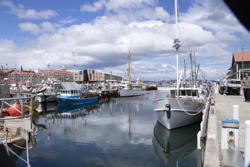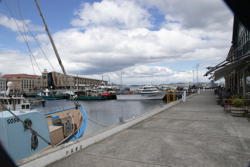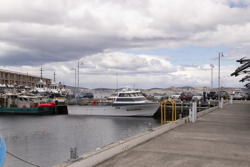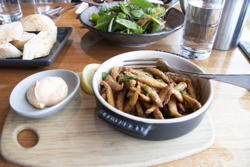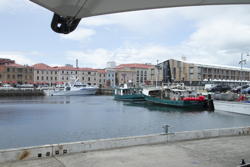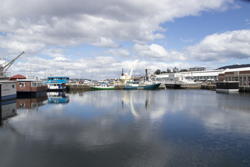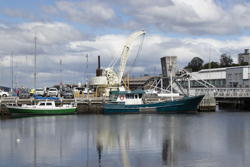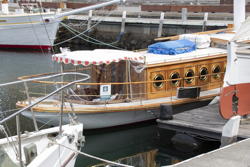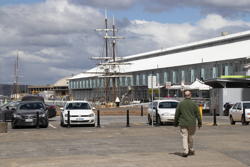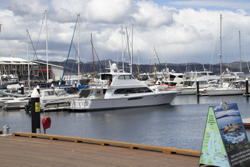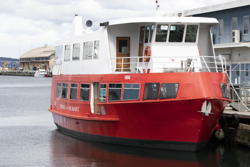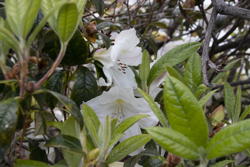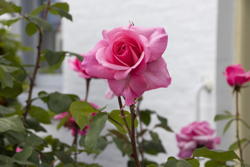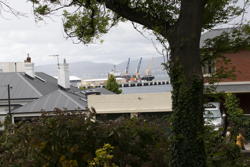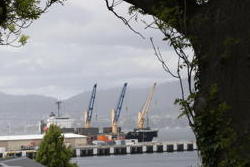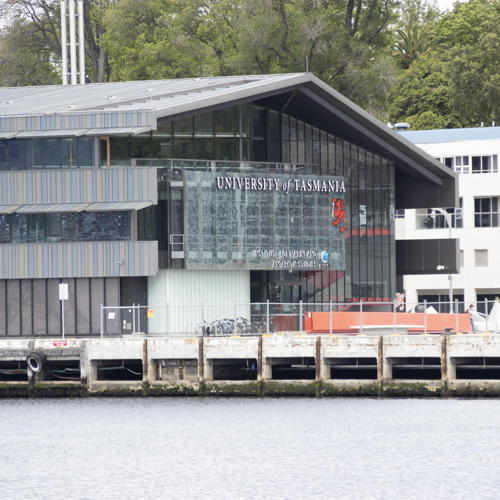
|
|
The University of Tasmania has this campus right on Hobart
harbor. Pass your mouse over the picture and get a closeup that is a reminder that Hobart is the jumping-off place for Antarctic exploration, not only Australia’s, but also that of France. |
November 8, we land in Hobart and walk
and
eat and walk and eat
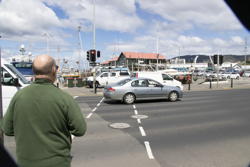
The flight from Melbourne to Hobart was only about an hour in duration, and there were no difficulties at all in getting settled in our hotel, the Old Woolstore Apartment Hotel, right in the thick of things in Hobart. After we dropped our stuff off there, we went out for a day of sightseeing. And eating, since Tasmania has recently gotten something of a reputation for seafood. It was only a short distance to the harbor, and there we could walk along the quay and, in effect, look in on the boats and their owners’ activities.
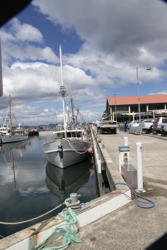
Hobart has a lot going on, what with being the capital city of Tasmania, a big tourist destination, especially for cruise ships, and the nexus of a lot of Antarctic exploration. The ever-reliable Wikipedia doesn’t say anything about Hobart as a fishing center, but we certainly saw a lot of boats of all sizes that were obviously engaged in fishing.
There were plenty of restaurants right there along the harbor, some even floating at quay, but for some reason I was less interested in getting photos of these than of pointing my camera out to the boats and ships that were moored there. We stopped in to a restaurant called Pearl+Co, which mentioned oysters prominently in its street signage, and oh, were the oysters there good! But the Tasmanians, and I suppose the Australians generally, seem to make no effort to preserve the inside liquid of the critter, so that it comes to you in its shell drained. I always enjoy lifting the otherwise empty shell to my lips to sip the last milliliters of the oyster’s essence, but there was no chance of that here. Notice in the picture that the shells are much deeper, more concave than our North American oysters. They could have held a lot of liquor, too.
In New Zealand, “whitebait” refers to the larvae of a fish that nobody eats when it’s mature. They look like short white worms with tiny little black eye-spots. Here in Tasmania, the term refers to fully-developed little fish, maybe they count as fry, but you can’t call them larval. They’re big enough that they can be deep-fried, and that’s how I had them at this meal. They were good, but not as exotic as the NZ whitebait.
After lunch, we went out for a serious walk, taking lots of pictures, and stopping into several galleries. I even ventured into a bookstore, where I bought the latest Ian Rankin, In a House of Lies, which I had not seen in any US store. It’s a big paperback, and I carried it around with me too much, as I’ll mention in tomorrow’s page. (It is a good one, though.)
Below, some of the pictures from our afternoon walk:
It was a beautiful time of the Spring, and as we walked up into the hills, we could admire the front-yard gardens of the houses that were above the town.
The deciduous rhododendrons available in nurseries are usually called Exbury Azaleas, as far as I can tell. I tried growing one in Providence, but it seemed to be subject to some kind of fungus, and lasted only a couple of years. Where they originated I have not found out; I have seen deciduous rhododendrons growing wild in Rhode Island, but with much smaller flowers.
Below the flowers, two more shots of the harbor, but taken from the same spot rather high in the hills, one shot rather more of a close-up than the other.
After our walk, it would soon be time for dinner. Let me quote from my journal: «Back to the hotel, where I took my boots off and relaxed for a while, before we went out for a meal at Franklin, which Mark researched on the internet by searching for the best restaurant in Hobart.
«Franklin is rigid in its adherence to its menu. M asked for his usual Perfect Manhattan, and they did have rye for making one, but the bartender would make only the cocktails listed. They did have a Martini, but made of vodka, which I ordinarily avoid. Their gin drink was a Negroni, and I could well have tolerated that, but M saw no cocktails on the list. Old Fashioned was offered to him but he turned his nose up at that, too . So we ordered a bottle of Tasmanian wine, Pinot Noir, and it turned out to be very good. But it was presented rather colder than we prefer; when it warmed up, it tasted even better.
«The menu presented courses that were not bites, but which ranged from lighter to heavier. At the bottom of the list, the cost was A$40, at the top around fifteen. We chose four, to be shared, and we left it to the staff to choose the order and combination. In the event, they came out one by one. First was a slow-cooked long onion like leeks, Tropea onion. As with leeks, the top part was rather sringy, but the taste was pleasing. Sweet, of course, as one expects with onions, especially after long cooking.
«Next was octopus, wood roasted, with adornments. Very tender but with enough tooth-resistance to be interesting — a nice contrast to M’s octopus earlier in the day, which I found kind of tough.
«After that, a potato galette: a wedge of scalloped potatoes. Again, extremely tasty.
«Finally lamb, roasted, very rare, very lean, very tender. Absolutely delicious. There were eight slices, about ¼" thick which we shared, as indeed we had shared all the dishes.”
By this time, we were well ready for bed. The Freycinet group would be forming at 0800 in our lobby, so we turned in. Coming up: you can read all about our next day’s adventure.
